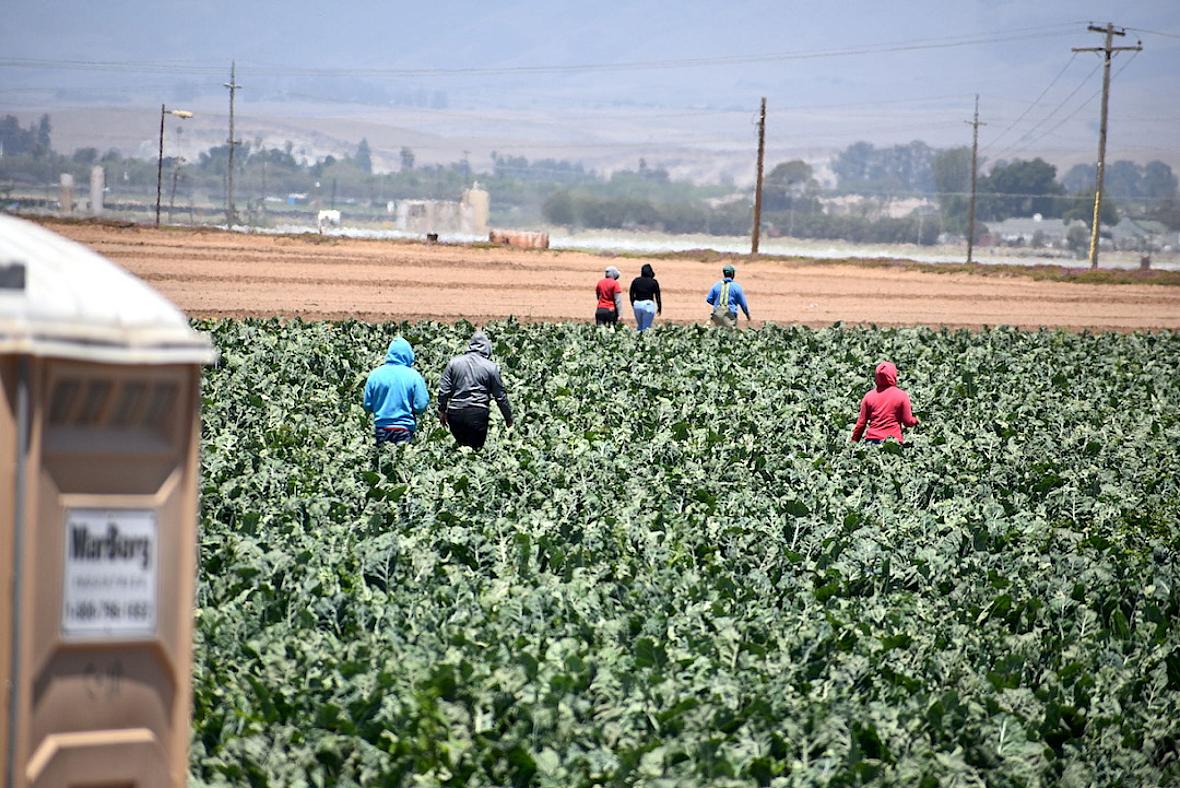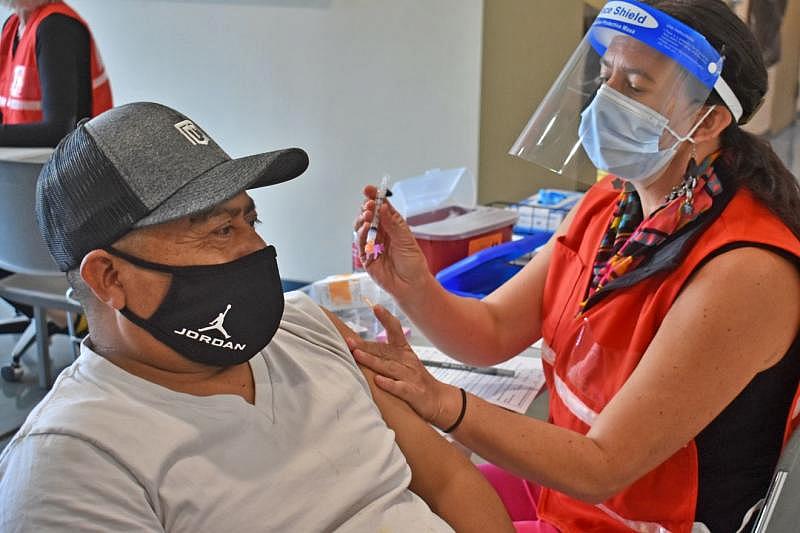Prevention Efforts Aimed at Farmworkers Crucial in County’s Fight Against COVID-19
This story is part of a larger project by Brooke Holland, a 2020 Data Fellow, who explores government and community partnerships formed in Santa Barbara County to help those at greater risk of contracting COVID-19, such as residents in skilled nursing homes, migrant farm workers, jail inmates, college students and people experiencing homelessness.
Her other stories include:
To reach Santa Barbara County’s vulnerable, public health targeted COVID-19 testing, drop-in sites
Coronavirus ‘Spread Extremely Easily’ in Skilled-Nursing Facilities, with Deadly Consequences
Santa Barbara County Public Health Partnered with Congregate Facilities on Virus Prevention
In Post-Vaccination Life, Residents Return to Lunches, Events, Visits at Long-Term Care Facilities
Maravilla Senior Living Community Held Earth Day Celebration for First Post-Vaccination Gathering
Santa Barbara County Farmworker Advocates, Agricultural Businesses Reflect on Pandemic

A countywide task force focused on pandemic prevention efforts for the agricultural community, including farmworkers in the Santa Maria Valley. At least 64 agricultural workers died of COVID-19, according to the Public Health Department.
(Brooke Holland / Noozhawk photo)
[Noozhawk’s Note: This story is one in an exclusive series investigating the toll of COVID-19 outbreaks in Santa Barbara County, and efforts to prevent and contain coronavirus outbreaks.]
Collaboration, education and outreach to agricultural employers and community organizing groups directly engaged with agricultural workers were among the most critical prevention efforts in the fight against COVID-19 in Santa Barbara County.
The Latinx and Indigenous Migrant COVID-19 Response Task Force helped stakeholders get access to public health leaders and keep the agricultural community informed, and community partners collaborated to create targeted testing and vaccination access for local farmworkers.
At least 64 agricultural workers have died of COVID-19 in Santa Barbara County, according to public records requested by Noozhawk.
The Public Health Department has reported 30 separate novel coronavirus outbreaks among agricultural businesses since the pandemic started, and about 330 positive cases were reported related to those outbreaks.
The county does not have occupational information for every person who has tested positive — it's not mandatory and people filled it out in about 54% of cases — but as of late May, reported more than 1,800 positive cases among agricultural workers.
Public health and community organizations have focused on agricultural workers' vulnerability since the beginning of the pandemic, because of crowded working and living environments and other social determinants of health.
A network of partners collaborated on public information, infection prevention, testing and COVID-19 vaccination efforts for farmworkers and other agricultural workers.
The Rush to Vaccinate Farmworkers
The COVID-19 landscape among agricultural workers has vastly changed with the introduction of widespread vaccination.
The county Public Health Department collaborated with growers and community organizers to hold vaccination events at workplaces and other convenient locations for agricultural workers.
The number of outbreaks has taken a significant downturn, along with overall case counts in these industries, public health officials said.
Pedro Martinez, a Santa Barbara County agriculture worker, receives a COVID-19 vaccine from nurse Morena Loomis during a pilot vaccination clinic hosted by the Santa Barbara County Public Health Department in Santa Maria on Feb. 28. (Janene Scully / Noozhawk photo)
Through partnerships, many established in pre-pandemic times, Public Health has been able to lean on trusted community leaders to engage agricultural workers and provide access to resources.
Community members and public health officials praised the success of the first farmworker vaccination clinic in Santa Maria, held in late February, for making the shots accessible at a time and place that was convenient for people. The clinic was also staffed with interpreters who spoke Spanish and Mixteco.
The pilot vaccination clinic provided an opportunity for people to get vaccinated and access to public health information, said Fernando Martinez, community organizer with Mixteco Indigena Community Organizing Project.
“Our indigenous farmworker communities do not have the same access and information compared to other workers,” Martinez told the Board of Supervisors during public comment at a March meeting.
The Mixteco Indigena Community Organizing Project relies on the collaboration with the Public Health Department to provide support to “one of the most disadvantaged communities in the Central Coast,” Martinez said.
Sandra Espino, who also spoke during the meeting, said she’s a proud daughter of farmworkers.
“I was immensely worried about my parents’ exposure to COVID as essential workers,” Espino said. “My mother does not drive and has been ride-sharing for decades to and from work. This is the reality of many farmworkers.”
Because she is able to work remotely during the pandemic, Espino said, she woke up at 5 a.m. to drive her mother to work and also pick her up from work. Espino planned to continue to do so until she and her mother were fully vaccinated against COVID-19.
“Farmworkers are the best people in our community,” Espino said.
As a volunteer with the Central Coast Alliance United for a Sustainable Economy (CAUSE), Espino registered more than 20 farmworkers for a vaccination pilot program.
“All of them were immensely grateful for the opportunity,” Espino said.
The first farmworker vaccination clinic also made Public Health officials recognize another barrier to vaccination: booking a COVID-19 vaccination appointment often requires an email address for confirmation, which can block access for people without digital access or Internet.
Farmworkers need additional support in using online platforms “if that’s what we are going to use to distribute vaccines,” Espino said. “All of these farmworkers speak Spanish and have limited access to technology."
“This is why these equity-focused distributions of vaccine are of utmost importance," she continued. "We often take for granted our ability to speak English. Our ability to navigate the Internet, and our access to email.”
The county hosted more vaccination clinics specifically for agricultural workers, in addition to its mass vaccination locations and walk-in mobile clinic times around the county.
Using a Task Force to Collaborate on Novel Coronavirus Prevention, Response Efforts
A major success was creating a task force with the county Public Health Department, UC Santa Barbara, and community organizations that came together during a crisis to provide fast response, and access to resources to the Latinx and indigenous migrant communities, said Latinx and Indigenous Migrant COVID-19 Response Task Force coordinator Andrea Medina.
“They were able to create the task force to provide services to the community,” said Medina, who started her position with the task force in October. “In and of itself, it's something that at least in the years that I've been in Santa Barbara has not happened in the past.”
The Latinx and Indigenous Migrant COVID-19 Response Task Force formed three Santa Barbara County-based working groups: the Farmworker Working Group, the Wellness Working Group, and the Lompoc Prison Task Force.
The groups held regular meetings to hear from community leaders addressing COVID-19’s disproportionate impact on historically marginalized groups.
"At the beginning of the pandemic, while everyone was being affected by COVID-19, the numbers of Latinx and indigenous communities were augmenting rapidly in our county, particularly farmworkers,” Medina said.
There was an urgent need to get COVID-19-related information out as soon as possible, Medina said, and multimedia outreach materials were created in multiple languages, including flyers and videos.
Several task force meetings and strategy sessions were held to respond to urgent priorities.
During meetings, county public health officials would present key information, and provide a space for questions and answers, “which was needed and meaningful at the time and still is now,” Medina said.
Various organizations, as well as families and community members could access meetings in English and Spanish, as well as interpretation in several variations of Mixteco languages.
“In all of these spaces, language access has been key because there were spaces where people in the community could get information in their own language, attend meetings, ask questions in the language that they feel most comfortable speaking and understanding,” Medina said.
Latino and indigenous migrants can face unfavorable social determinants of health, including crowded housing, crowded transportation, and crowded work environments.
Farmworkers are frequently side-by-side at work when there is limited shade protection in their work stations. In some cases, employees do not have access to clean water for hand-washing in the workplace.
“Those were all critical social determinants of health that impacted people's COVID risk,” said Melissa Smith, the director of Health Equity Initiatives at UC Santa Barbara who co-founded the task force last year.
Smith was involved in the guidelines for reopening the county during the pandemic, which included some public health rules for workplaces, such as access to bathrooms and hand-washing.
“That's one example of having health officer orders that had a positive impact on that critical social determinant of health,” Smith said.
The task force created a space to hear the voices and concerns of people because community members and farmworkers were part of meetings, as were local organizations that work closely with them.
“We use the social justice principles of community-based participatory research to guide the work of the task force, so the focus is centering the voices and leadership of communities who've been historically marginalized,” Smith said.
“You had the power of having community members and community organizing groups working with them, voicing specific, concrete and pressing needs,” Smith added.
More than 90 partners, including community-based organizations, the county Public Health Department and Department of Behavioral Wellness, UC Santa Barbara, health service providers, elected officials, funders and other partner groups “could respond and coordinate together to provide a coordinated collaborative response,” Smith said.
There was an urgency to focus on the specific needs of the Latinx and indigenous migrant communities because of language barriers and immigration status, Smith said.
In late March last year, the task force noted a critical need for expanded interpreting services for telemedicine and clinical care with safety-net providers and hospitals.
The task force's solution was clarifying with healthcare providers what interpretation services are available for people, and identify other languages and interpretation resources.
A priority of the task force included outreach with public service announcements in Spanish and multiple indigenous languages via radio, Facebook and other social media.
Social network apps have been a powerful tool of communication during the pandemic, Smith said.
"One of the things that I learned through some of our community organizing partners is the use of social media, texting, Facebook Live and other social media strategies to reach folks, especially using indigenous languages," Smith said. "It's a powerful way to reach people through their phones, who may otherwise experience barriers to the internet or computers."
Early in the pandemic, community members said that they were not getting tested for the novel coronavirus because of barriers they experienced, Smith explained.
There was a need early on to provide information about free services because patients were avoiding care due to fear of costs, according to the task force.
Soon after concerns were raised by the task force in March 2020, the county Public Health Department made a policy decision to waive some COVID-19-related patient care copay charges.
Community Health Centers of the Central Coast, or CHC, offered COVID-19 testing and health education in Spanish and Mixteco, as well as free access to care in several clinics in the North County.
The task force in May 2020 recognized the hurdles in making testing appointments for residents who did not speak English.
Task force partners distributed masks at farms, health centers, grocery stores, laundromats, parking lots and other busy locations around Santa Maria.
The Latinx and Indigenous Migrant COVID-19 Response Task Force has listed a wide variety of more than 200 priority action areas and concerns throughout the pandemic, as well as about 150 possible solutions in response.
"I feel like I've learned so much in this process," Smith said. "I feel such gratitude for the wisdom and the expertise of the community organizing groups with whom we work."
[This story was originally published by Noozhawk.]
Did you like this story? Your support means a lot! Your tax-deductible donation will advance our mission of supporting journalism as a catalyst for change.
